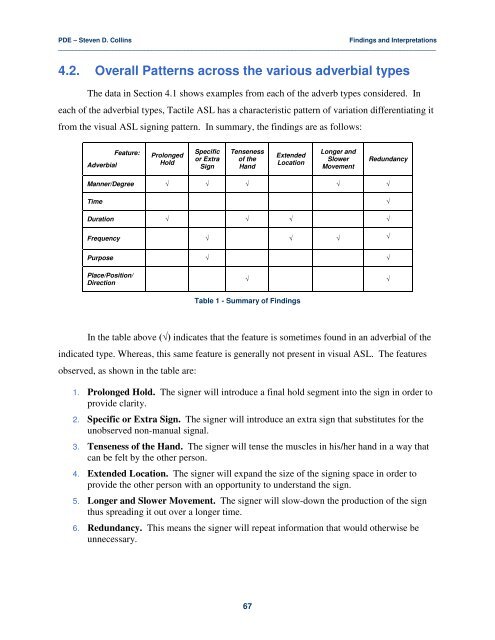Adverbial Morphemes in Tactile ASL - Gallaudet University
Adverbial Morphemes in Tactile ASL - Gallaudet University
Adverbial Morphemes in Tactile ASL - Gallaudet University
Create successful ePaper yourself
Turn your PDF publications into a flip-book with our unique Google optimized e-Paper software.
PDE – Steven D. Coll<strong>in</strong>s<br />
F<strong>in</strong>d<strong>in</strong>gs and Interpretations<br />
_________________________________________________________________________________________________________<br />
4.2. Overall Patterns across the various adverbial types<br />
The data <strong>in</strong> Section 4.1 shows examples from each of the adverb types considered. In<br />
each of the adverbial types, <strong>Tactile</strong> <strong>ASL</strong> has a characteristic pattern of variation differentiat<strong>in</strong>g it<br />
from the visual <strong>ASL</strong> sign<strong>in</strong>g pattern. In summary, the f<strong>in</strong>d<strong>in</strong>gs are as follows:<br />
<strong>Adverbial</strong><br />
Feature:<br />
Prolonged<br />
Hold<br />
Specific<br />
or Extra<br />
Sign<br />
Tenseness<br />
of the<br />
Hand<br />
Extended<br />
Location<br />
Longer and<br />
Slower<br />
Movement<br />
Redundancy<br />
Manner/Degree √ √ √ √ √<br />
Time<br />
√<br />
Duration √ √ √ √<br />
Frequency √ √ √ √<br />
Purpose √ √<br />
Place/Position/<br />
Direction<br />
√<br />
√<br />
Table 1 - Summary of F<strong>in</strong>d<strong>in</strong>gs<br />
In the table above (√) <strong>in</strong>dicates that the feature is sometimes found <strong>in</strong> an adverbial of the<br />
<strong>in</strong>dicated type. Whereas, this same feature is generally not present <strong>in</strong> visual <strong>ASL</strong>. The features<br />
observed, as shown <strong>in</strong> the table are:<br />
1. Prolonged Hold. The signer will <strong>in</strong>troduce a f<strong>in</strong>al hold segment <strong>in</strong>to the sign <strong>in</strong> order to<br />
provide clarity.<br />
2. Specific or Extra Sign. The signer will <strong>in</strong>troduce an extra sign that substitutes for the<br />
unobserved non-manual signal.<br />
3. Tenseness of the Hand. The signer will tense the muscles <strong>in</strong> his/her hand <strong>in</strong> a way that<br />
can be felt by the other person.<br />
4. Extended Location. The signer will expand the size of the sign<strong>in</strong>g space <strong>in</strong> order to<br />
provide the other person with an opportunity to understand the sign.<br />
5. Longer and Slower Movement. The signer will slow-down the production of the sign<br />
thus spread<strong>in</strong>g it out over a longer time.<br />
6. Redundancy. This means the signer will repeat <strong>in</strong>formation that would otherwise be<br />
unnecessary.<br />
67
















